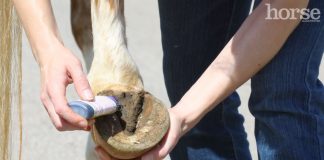Your horse is lame, but with no obvious signs of injury to the leg, so you call your farrier in to look him over. The farrier asks you on the phone when you make the appointment whether the lameness is bilateral or unilateral. He arrives at your barn and goes through the checklist as he examines your horse’s feet. It might be caused by an abscess in the anterior medial sole. Or maybe the lameness was created by the imbalance between the medial and lateral hoof wall or a bruise to the sole. Perhaps the lameness is due to a puncture wound in the posterior portion of the frog or contracted heels or excessively long toes and low heels.
The definition of “farrier” is: “a craftsman who cares for a horse’s feet, including foot trimming, balancing of hooves and the setting of shoes.” The farrier combines the skills of the related field of blacksmithing (definition: “one who forges items out of black metals: iron or steel” ), with some of the veterinarian’s (knowledge of anatomy and physiology of the lower limbs of the equids) and with the abilities of a good horseman mixed in.
According to several sources, the words farrier and blacksmith are related. Both came into usage in the 15th Century in Europe. Wikipedia notes that the Middle French word “ferrier” meant blacksmith, while the Latin word “ferrum” meant iron. The Merriam-Webster dictionary cites that our modern word farrier is an alternation of the Middle English/Anglo-French word “ferrour” and that Vulgar Latin (the common or vernacular form of Latin) used the term “ferrare” for iron.
The main thing to note from seeing all of the European language sources for the word “farrier” is that the job was a super important one throughout the world from the time horses were domesticated on through the centuries. Horses and oxen (who were also shod by farriers) were sources of transportation for humans, labor to till the fields, used as pack animals and pulled carts and wagons to transport goods, and were an integral part of any Army from ancient times through World War I. It suffices to say that without the work of farriers, the world would have ground to a screeching halt.
According to the Tucson School of Horseshoeing, 80% of horse lameness issues are due to improper shoeing and poor care of the horse’s feet. The American Veterinary Medical Association estimates that American horse owners lose approximately $800 million dollars each year due to lameness problems.
While we don’t use cavalry or work horses in most cases anymore, considering the time, money and love that we expend on our modern-day equine partners, the farrier should remain a VIP to today’s horse owners as well!
Liked this article? Here’s more info on hoof care:
Alternative Hoofwear Options
Guide to Horse Hoof Problems
Kim MacMillan has been journalist and photographer for over 35
years. She graduated from Purdue University with degrees in agriculture
journalism and animal science. She and her husband Allen, who is also a
sports photographer, raise sport horses and ponies on their 84-acre farm
in Northeastern Indiana.








Always good to keep in mind. Especially as I’m reshoeing my horse right now.
Excellent article! Besides improper shoeing, housing is also a big problem. I.E. if a horse is stalled the stall needs to be cleaned daily and have proper bedding.
Sometimes a horse owner may neglect their chores for a day or two and allow the bedding to become saturated. This can lead to thrush and many other problems.